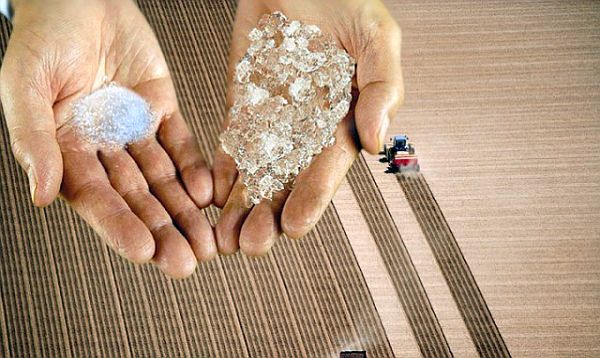"Solid Rain" looks like sugar, and sells for $25 a pound. And if you’re a bit skeptical of its maker’s claims, we understand.
This Mexican product, which bills itself as a "miracle powder that could solve the world’s drought problems," seems like it belongs right alongside magic beans and Herbalife on the "I wasn’t born yesterday" spectrum.
But rest assured - Solid Rain is very real, and very effective. The product's creator, Sergio Jésus Rico Velasco, is a Mexican chemical engineer who spent decades trying to mitigate his country’s drought issues."
His initial inspiration for his invention was baby diapers, an item that absorbs lots of liquid in a minimal space.
That’s the basic process used by Solid Rain. It’s a highly absorbent polymer called potassium polyacrylate - a substance which has the ability to absorb as much as 500 times its mass in water.
A whole liter of water can be absorbed in just 10 grams of Solid Rain, which converts into a thick, translucent gel. The water is then retained for up to a year, and it will not evaporate, run off into the soil, or go anywhere until it’s consumed by a plant’s roots. Think of it like a little powdered reservoir.
The Mexican government conducted a one-season sample study on farmers in the semi-arid state of Hidalgo. Side-by-side, farm plots showed up to 300 percent increases in crop yield when Solid Rain was used.
For instance, the comparison of oatmeal showed a huge jump in yields — 5,500 lbs per 2.5 acres in fields without Solid Rain versus 11,000 lbs in fields with it. Sunflowers were 2000 lbs per 2.5 acres versus 6,600 lbs with. And bean yields went through the roof, with a difference of 1000 lbs per versus 6,600 lbs.
Solid Rain has been nominated twice for a Global Water Award by the Stockholm International Water Institute; it received the Ecology and Environment award from the Fundacion Miguel Aleman; and it’s been used in Mexico for a decade. But chances are, you’ve never heard of it until now. That may be simply a failure in marketing.
For the last 10 years, the product’s main advertising strategy was word-of-mouth between Mexican farmers. "It was a pretty grassroots operation," says Edwin Gonzalez, Vice President of the Solid Rain company. "There wasn’t any real marketing."
The company just gained approval to sell in the US last fall, but so far, they haven’t made much headway there.
Gonzalez says: "Blame the weather."
If Solid Rain had just gained approval before or during last year’s killer droughts, he thinks it would’ve sold like gangbusters — and saved untold crops in the process. But with this year’s flooding, the market has been a bit, well, dry.Of course, water conservation is a smart play in any kind of weather, and Solid Rain is trying to expand its target market beyond farmers. Its website targets golf course owners and homeowners with lawns, especially in the water-starved Southwest.San Diego resident Patricia Lorenzo says Solid Rain has done wonders on her lawn; she’s cut her weekly sprinkler time from 45 minutes to just six minutes. She also only had to water her home garden - fig trees, corn, an herb box - four times since April.Lorenzo also touts a side benefit of Solid Rain: it prevents nutrients in the soil from washing away.
Frank Torres, a former green bean farmer in the Mexican state of Sinaloa, used Solid Rain even though drought wasn’t a big issue in his area. Still, he said yields increased by about 50 percent.
"Nitrogen wasn’t washing away every time we watered the plants," Torres said. "All the nutrients were absorbed into the roots."


